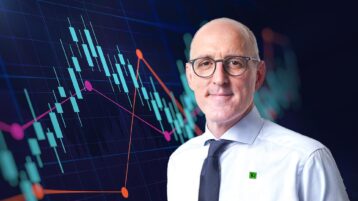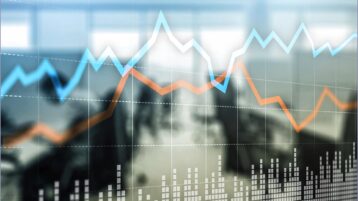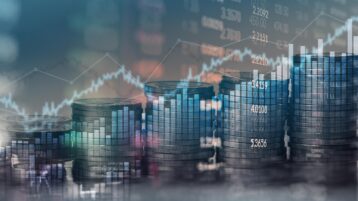Even as signs of economic weakness emerge, central banks are pledging to stay the course in their inflation fight. Anna Castro, Managing Director and Head of Retail Asset Allocation at TD Asset Management, explains how the current environment could lead to more options for income.
Print Transcript
[AUDIO LOGO]
* Central banks may be at a crossroads as we begin to see signs of a slowing economy. So what does it all mean for asset prices heading into the fall? Joining us now to discuss, Anna Castro, Managing Director and Head of Retail Asset Allocation at TD Asset Management. Anna, it's great to have you back on the show.
* Thank you. Nice to be here.
* We've come out of a long weekend. You get a sense that people are going to start a little more serious getting back to their desks. We got interest rate announcements this month, and we've had a run of economic data through the summer that's been a bit mixed, but some signs of slowing. What could it all mean for central banks?
* It gives the central bank options on how to manage the path from here. So they want to be data dependent because they've had over a year of aggressive rate increases, both in Canada-- Bank of Canada, as well as Federal Reserve. And you've seen some economic data slowness from economic activity, spending. Wages, while still increasing, is not as hot as they were before, but people still remain employed. On the flip side, inflation has also been trending lower from high single digits before, to now more on the four handle, 4% handle, and could be like high threes towards the end of the year.
* However, it's still not totally under control wherein the central bankers can move past it and say we've won the war. So from here on forward, they want to watch how the data indicates how their tightening has flown into the system, to the economy, corporations, and consumers, but they want to have flexibility to go back and make sure that inflation is trending to where they would be comfortable in.
* Yeah, you get the sense when you hear from either Tiff Macklem and our country, our central bank governor-- you hear from Jay Powell south of the border-- a real reticence to say mission accomplished. They don't want to declare the fight as won because that can have dangerous consequences on the other side.
* Yes, they want to make sure that they have price stability, which is-- and inflation is their priority right now. The other component of their mandate is to make sure that there's full employment, and employment labor, as I mentioned, is pretty strong, so that's not a worry. Growth is OK, has been resilient. And if anything, they want to make sure that they don't have inflationary pressures come back because we've had some of those rear their head, and they want to make sure that they really firmly control it.
* Now, if we take them at their word, they've been telling us, they may not be done yet. If they need to go a little more, they will. And then they're going to stay there for a while. They're going to keep interest rates elevated. If that's the reality that we're looking at, maybe no more hikes, maybe a hike or two depending on the data that comes in, as you said, and then you stay there for a while. What does it actually mean for asset prices?
* So in terms of asset prices, you have more options for income. So in this environment, you have fixed income. Bond yields are higher, which means, unlike what we have in prior decades, you now have a higher level of income, for example, a basket of bonds, high quality government, and corporates could give you about 5%, which you haven't seen in multiple decades. That also means you have GICs, high savings account offering alternatives in terms of high level of income compared to equities.
* And so you have more choices in terms of your investment universe. However, that also means higher bond yields will impact valuation. So that would also pressure prices of the equity market, which has had a very strong run year to date. It's all about managing expectations from where we are here. The other component, too, is a high level of interest rate. It's not just about valuation, but also it's a way to curtail demand. It's higher cost of debt, higher cost of spending, so this could also impact economic growth and the expectations moving forward.
* So if we expect higher interest rates than we had before, or higher cost of spending, you could have lower economic growth moving forward and that means earnings expectations should also come down.
* This is what the central banks are trying to engineer. They're saying we had inflation that was way too high for comfort. We need to bring it down. To do that, you slow an economy. You slow a labor market. So at this point, where we are, perhaps at a crossroads for the central banks, are we at a crossroads for the economy? I mean, what is the economy telling us about where we are in the cycle?
* So we are in the late stage in the cycle. So far, the economy has been resilient because of the strong labor market. The key question here is, when-- central banks, when they increase interest rates, they try to impact demand, but it's very blunt, and it takes time to flow through. So we're like a little bit of a year into it. So next year, you'll have more time for this tightening to flow through. In the late-stage of the economy, you really need to think about quality of your investments.
* First of all, you need to think about the price that you bought that investment because you need-- the price that you pay impacts your long-term returns in that investment. Second, having a good source of income helps you weather through you, yourself as an investor, higher interest rates and higher inflation, or inflation higher than before.
* The other component too is to make sure that the companies that you lend to, as well as that you buy, have the capability to weather this wide range of economic environment, can be able to stand a weakening economic demand, can be able to price-- pass through price increases if needed, have different sources of demand for their goods and services and have a strong balance sheet to have access to capital and be able to afford a higher cost of interest when they have to refinance their debt moving forward.
* And so in that type of environment as an investor, you have to really think through and do your due diligence, look at the different scenarios, sources of cash flows of what you're investing into, whether it's fixed-income equities, or alternatives. And it's important to have a diversified investment so that you have different sources of returns there, and they can take into account different time horizons.
* So what I'm saying is not to put all your eggs in one basket, and what has worked perhaps last year or early this year, may not work moving forward. So important to assess really what you're buying into and what you're holding in your portfolio.
* I wanted to ask you about that, about what has worked so far, not working going forward based on all that, because certain parts of the equity market, whether it's tech, particularly big tech in the US, has had a good run so far this year. We're starting to see oil companies gain off the back of crude, or is the market being a little too optimistic that you get the no landing, the soft landing, everything is going to be just fine, we get inflation under control, and no one gets hurt?
* So the equity-- so the fixed-income market have seen volatility the past few weeks, so you're seeing volatility on the bond side. On the equity market, yes, we do believe it is more complacent. You're not seeing volatility-- much volatility there, and they're expecting, for example, the S&P 500 next year earnings growth of 12%. That's quite high on later in the cycle. The situation is quite fluid. And what has happened this year-- because coming into this year, people expected worse, more of a recession early on, and you've had a relief saying that things are better, or the worst is behind us.
* What is being priced in is the worst is behind us. Moving forward, earnings is expected to grow 12%. The expectation, as well, is that you're going to have easier financial conditions, and in the past few months, you've had a lot of short covering, so that's why the market-- the equity market has done quite well. And in the case, the price action of both equities and high-yield credit has given people more confidence feeling that the worst is behind us.
* But in reality, what we'd like to highlight is that the price action is one thing. The other component is to be make sure that the earnings model of these companies, the sources of cash flows remain resilient as we enter a late stage in the cycle wherein there are different types of economic outcomes and financial conditions that could be possible, or even like a higher-- not just higher interest rate for longer, but also, a higher than the past inflation rate.
* So all of this has to come into play before quickly thinking that everything is going to be like it was before, earnings will accelerate, and the Fed will cut, and that means lower interest like it was in the past. I think it's important to be prudent and thoughtful in the process.
[SOFT MUSIC]
* Central banks may be at a crossroads as we begin to see signs of a slowing economy. So what does it all mean for asset prices heading into the fall? Joining us now to discuss, Anna Castro, Managing Director and Head of Retail Asset Allocation at TD Asset Management. Anna, it's great to have you back on the show.
* Thank you. Nice to be here.
* We've come out of a long weekend. You get a sense that people are going to start a little more serious getting back to their desks. We got interest rate announcements this month, and we've had a run of economic data through the summer that's been a bit mixed, but some signs of slowing. What could it all mean for central banks?
* It gives the central bank options on how to manage the path from here. So they want to be data dependent because they've had over a year of aggressive rate increases, both in Canada-- Bank of Canada, as well as Federal Reserve. And you've seen some economic data slowness from economic activity, spending. Wages, while still increasing, is not as hot as they were before, but people still remain employed. On the flip side, inflation has also been trending lower from high single digits before, to now more on the four handle, 4% handle, and could be like high threes towards the end of the year.
* However, it's still not totally under control wherein the central bankers can move past it and say we've won the war. So from here on forward, they want to watch how the data indicates how their tightening has flown into the system, to the economy, corporations, and consumers, but they want to have flexibility to go back and make sure that inflation is trending to where they would be comfortable in.
* Yeah, you get the sense when you hear from either Tiff Macklem and our country, our central bank governor-- you hear from Jay Powell south of the border-- a real reticence to say mission accomplished. They don't want to declare the fight as won because that can have dangerous consequences on the other side.
* Yes, they want to make sure that they have price stability, which is-- and inflation is their priority right now. The other component of their mandate is to make sure that there's full employment, and employment labor, as I mentioned, is pretty strong, so that's not a worry. Growth is OK, has been resilient. And if anything, they want to make sure that they don't have inflationary pressures come back because we've had some of those rear their head, and they want to make sure that they really firmly control it.
* Now, if we take them at their word, they've been telling us, they may not be done yet. If they need to go a little more, they will. And then they're going to stay there for a while. They're going to keep interest rates elevated. If that's the reality that we're looking at, maybe no more hikes, maybe a hike or two depending on the data that comes in, as you said, and then you stay there for a while. What does it actually mean for asset prices?
* So in terms of asset prices, you have more options for income. So in this environment, you have fixed income. Bond yields are higher, which means, unlike what we have in prior decades, you now have a higher level of income, for example, a basket of bonds, high quality government, and corporates could give you about 5%, which you haven't seen in multiple decades. That also means you have GICs, high savings account offering alternatives in terms of high level of income compared to equities.
* And so you have more choices in terms of your investment universe. However, that also means higher bond yields will impact valuation. So that would also pressure prices of the equity market, which has had a very strong run year to date. It's all about managing expectations from where we are here. The other component, too, is a high level of interest rate. It's not just about valuation, but also it's a way to curtail demand. It's higher cost of debt, higher cost of spending, so this could also impact economic growth and the expectations moving forward.
* So if we expect higher interest rates than we had before, or higher cost of spending, you could have lower economic growth moving forward and that means earnings expectations should also come down.
* This is what the central banks are trying to engineer. They're saying we had inflation that was way too high for comfort. We need to bring it down. To do that, you slow an economy. You slow a labor market. So at this point, where we are, perhaps at a crossroads for the central banks, are we at a crossroads for the economy? I mean, what is the economy telling us about where we are in the cycle?
* So we are in the late stage in the cycle. So far, the economy has been resilient because of the strong labor market. The key question here is, when-- central banks, when they increase interest rates, they try to impact demand, but it's very blunt, and it takes time to flow through. So we're like a little bit of a year into it. So next year, you'll have more time for this tightening to flow through. In the late-stage of the economy, you really need to think about quality of your investments.
* First of all, you need to think about the price that you bought that investment because you need-- the price that you pay impacts your long-term returns in that investment. Second, having a good source of income helps you weather through you, yourself as an investor, higher interest rates and higher inflation, or inflation higher than before.
* The other component too is to make sure that the companies that you lend to, as well as that you buy, have the capability to weather this wide range of economic environment, can be able to stand a weakening economic demand, can be able to price-- pass through price increases if needed, have different sources of demand for their goods and services and have a strong balance sheet to have access to capital and be able to afford a higher cost of interest when they have to refinance their debt moving forward.
* And so in that type of environment as an investor, you have to really think through and do your due diligence, look at the different scenarios, sources of cash flows of what you're investing into, whether it's fixed-income equities, or alternatives. And it's important to have a diversified investment so that you have different sources of returns there, and they can take into account different time horizons.
* So what I'm saying is not to put all your eggs in one basket, and what has worked perhaps last year or early this year, may not work moving forward. So important to assess really what you're buying into and what you're holding in your portfolio.
* I wanted to ask you about that, about what has worked so far, not working going forward based on all that, because certain parts of the equity market, whether it's tech, particularly big tech in the US, has had a good run so far this year. We're starting to see oil companies gain off the back of crude, or is the market being a little too optimistic that you get the no landing, the soft landing, everything is going to be just fine, we get inflation under control, and no one gets hurt?
* So the equity-- so the fixed-income market have seen volatility the past few weeks, so you're seeing volatility on the bond side. On the equity market, yes, we do believe it is more complacent. You're not seeing volatility-- much volatility there, and they're expecting, for example, the S&P 500 next year earnings growth of 12%. That's quite high on later in the cycle. The situation is quite fluid. And what has happened this year-- because coming into this year, people expected worse, more of a recession early on, and you've had a relief saying that things are better, or the worst is behind us.
* What is being priced in is the worst is behind us. Moving forward, earnings is expected to grow 12%. The expectation, as well, is that you're going to have easier financial conditions, and in the past few months, you've had a lot of short covering, so that's why the market-- the equity market has done quite well. And in the case, the price action of both equities and high-yield credit has given people more confidence feeling that the worst is behind us.
* But in reality, what we'd like to highlight is that the price action is one thing. The other component is to be make sure that the earnings model of these companies, the sources of cash flows remain resilient as we enter a late stage in the cycle wherein there are different types of economic outcomes and financial conditions that could be possible, or even like a higher-- not just higher interest rate for longer, but also, a higher than the past inflation rate.
* So all of this has to come into play before quickly thinking that everything is going to be like it was before, earnings will accelerate, and the Fed will cut, and that means lower interest like it was in the past. I think it's important to be prudent and thoughtful in the process.
[SOFT MUSIC]



























